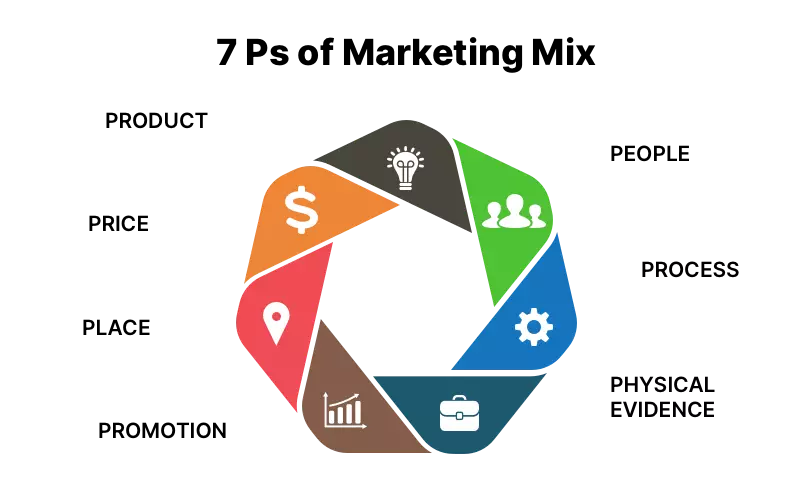Every marketing graduate can recite the ‘4 Ps of marketing’ in their sleep. But what they often don’t teach you at school is how to actually apply this knowledge.
I’ll show you how to ‘inject’ the Ps of marketing into your business to monetary results, instead of just ‘knowledge gains’.
And if you’re wondering… “so why is this article called The Marketing Mix 7Ps?” No worries, it’s not a typo.

It’s just some good old overdelivery.
So if you’re a business owner or you dream of becoming one, this article will be your go-to marketing foundation article.
Let me start by telling you a little story.
Remember Google Glass? That sci-fi-looking wearable that everyone thought was super cool, and then just dropped all of a sudden.
It wasn’t the tech. It was the marketing.
They made an amazing product, but did not bother to focus on the marketing.
So, what happened? People called users “Glassholes” and moved on. That name is actually hilarious.

Google thought: “Build it, and they will come. Let the product sell itself.”
Having a fantastic product is obviously important (and you’ll see how to make one later)… but it’s not the only important thing.
So here’s the most actionable “7Ps of Marketing” article you’ve EVER seen. Enjoy.
When you’re building your product, have a customer outcome in mind. Sure, it’s easier said than done, especially for services.
“Buy my service for $X and you’ll get $Y (with Y hopefully being larger than X 😀 )”
Or…
“Buy my weight loss coaching and lose 20 pounds in 3 months”…
But what do you say when you’re selling physical products like hoodies, bracelets, or custom mugs?”
Well… a mug can represent productivity. A recipe book is a slimmer waistline. A whiteboard is a place to visualize your goals. A diamond bracelet is an item to make you feel prestigious.
Do you see what I mean?
When you’re building (and then advertising) your product, focus on the transformation. Ask yourself: “What changes in someone’s life after they buy?”
Things change even when you sell mugs.
And when you add a sprinkle of USP, your product becomes a winner.

Another pro tip: OBSESS over being the best at solving the customer’s problem. That’s how you win long-term.
Very often, we just focus on selling a lot and making lots of money. But if your solution is not good, you won’t retain buyers.
I’m talking about my Startup Launch Roadmap eBook.
It’s designed to show you everything you need to know about creating a business plan, designing a product, attracting investments, and launching it.
If you’re a founder, this book will help you SO much. You can get it here:
Pricing is more than “cost + margin.” It’s a message.
You know… A $50 product feels cheap, while a $50K product can feel like a bargain if the outcome justifies it:
Guarantees can help a lot as well. People just feel less anxious to invest when they know that they can get their money back, should something go wrong.
Amazing pro tip #2: If you take sales calls, learn objection handling. There’s an answer to “I need to think about it.”, or “I don’t know if I want to invest that kind of money.” It will help you a lot.
I think almost every business should try to grow on social media. Seriously.
It’s one of the highest-leverage tools you’ve got. There are millions of people out there who might click on your profile.
I know it might feel “cringe” to record yourself speak, but it’s something that can get you tons and tons of sales. Just think about the money, okay?
And then, stop overthinking your distribution strategy and simply start creating.
Put your face out there, share results, tell stories, and link your offer.
(Obviously there’s more to it, but it’s really that simple.)
This might be the most important of the marketing mix 7Ps…
Promotion – especially in the early days – should take up a BIG chunk of your time.
As Alex Hormozi put it in a recent Facebook post:
About outreach…
When people receive personalized stuff, they pay attention to it.
I don’t just mean using a personalized name field and a compliment.
Film them a Loom video. Send them a prototype. Send them a handwritten letter.
Stand. Out!
In 2025, this is the only type of outreach that works.
Generic mass outreach won’t get you anywhere.
Of course, there are ways to scale this process. You can either delegate this, or you can build automated systems… or you can do it both!
For example, have a VA make lists, create a streamlined process for the personalized value, and have another person make the value.
This can get you a TON of opportunities.
Regarding content marketing, you should probably focus on video formats.
Yes, we write blogs, but we also turn those blogs into Instagram Reels and posts.
This way, our blogs are worth so much more, since they’re an asset we can use time and time again to get loads of leads.
Don’t chase likes and views… create authority content. It’s MUCH better to get 30k ideal client views than 1M random people.
I’m sure you know this one… but I still want to repeat it. We all need some repetition sometimes.
Don’t just sell what you want to sell. Deliver what they need.
Great marketing is human-centered.
You’re not selling a product. You’re selling a better version of them.
Sell logic AND emotion.
Yes, show the ROI. But also sell the feeling. The future view the customer will have of themselves. A new identity. A mission.
If you’re selling a mug, you’re selling a pre-work ritual. An object that will stand by the customer while they achieve their goals.
You have to BS it a little 😀
Your customer journey should feel like teleportation, not a maze.
Map every touchpoint. What happens after someone sends you money? What happens if they ghost? What emails go out? What onboarding steps? What updates?
PROFESSIONAL TIP: Automate the boring. Humanize the important.
For example…
A CRM that remembers birthdays is really nice. A handwritten “thank you” with the package? Daaamnnn…
You can’t hold a service in your hand. That’s why social proof matters.
People buy what OTHER people buy.
So collect every single win – testimonials, case studies, screenshots, videos, client shoutouts.
Post them EVERYWHERE. This will be the content that gives you the MOST authority.
And when they see enough of that? You become the “obvious choice.”
Don’t feel overwhelmed. You don’t need to master the marketing mix 7Ps this week.
But you do need to start. Pick the ones that move the needle most. If you’re just starting – Promotion, Product, and Price are your bread and butter.
You can layer the others over time. Here’s a quick recap of what we learned today:

Email subscription is available ONLY TODAY (oh, okay, and tomorrow).
Surely, we respect your inbox! Unsubscription works every day.

We’d love to tailor your experience — which of these best describes you?